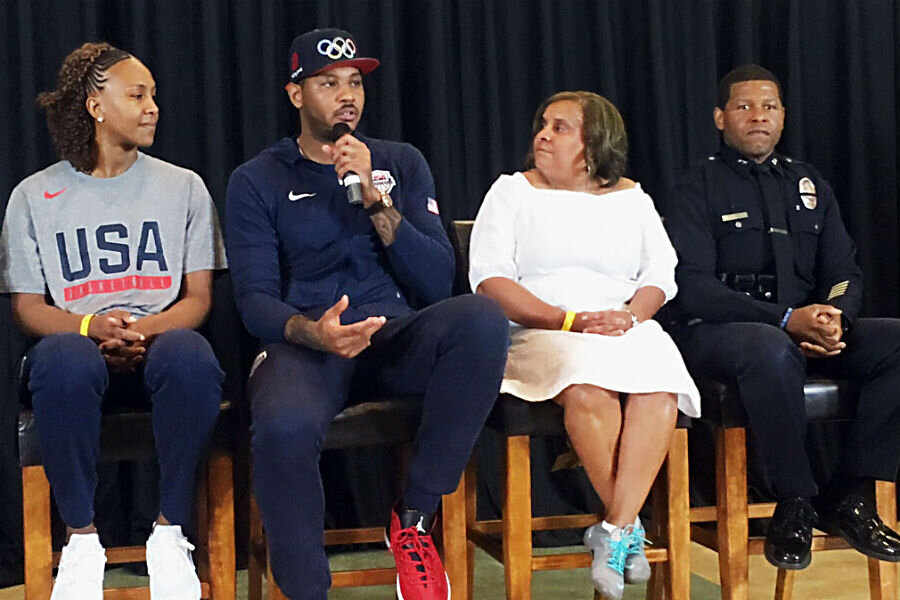Carmelo Anthony, Michael Jordan seek to build bridges with police
Loading...
Carmelo Anthony’s prowess is well known on the basketball court – as a forward for the New York Knicks he's averaged 21 points a game this season, and as a member of the Olympic team, he will represent the United States on the international basketball stage next month.
But on Monday, Mr. Anthony set up a different kind of play, calling together basketball stars, police officers, community leaders, and young people for a two-hour town hall about respect and communication at a Los Angeles Boys and Girls Club.
The meeting was meant to open up a dialogue to begin to mend relationships between community and police, said Anthony. He is among other National Basketball Association and Women's National Basketball Association players who have been using their position as role models and major figures in the American spotlight to speak out for change, particularly in the wake of violence this month, which included fatal police shootings of black men in Louisiana and Minnesota and deadly retaliation against police in Dallas and Baton Rouge, La.
The town hall meeting gathered together about 200 people and gave Los Angeles youth a platform to explain “how they feel about their community, how they feel about police officers, how they feel about relationships and how we can mend these relationships,” Anthony said, according to the Associated Press.
The meeting comes as a form of tangible action after Anthony posted a powerful message on Instagram recently where he called on fellow players to “demand change” of a “broken” system. In that post, reportedly composed in the middle of a sleepless night, he raised the question of what his next step would be, saying: “a couple social media post/tweet doesn’t work.”
“There’s NO more sitting back and being afraid of tackling and addressing political issues anymore,” he wrote in the post.
That sentiment is not Anthony’s alone. Legendary NBA player and Charlotte Hornets owner Michael Jordan has been known for keeping out of the fray of social and political commentary for decades. But in a statement released Monday, Mr. Jordan wrote “I can no longer stay silent” and condemned the “deaths of African-Americans at the hands of law enforcement” and “the cowardly and hateful targeting and killing of police officers.”
Like Anthony, Jordan didn’t limit his action to words: He pledged $1 million to the Institute for Community-Police Relations, a new initiative of the International Association of Chiefs of Police, and another million to the civil rights-oriented NAACP Legal Defense Fund.
These individual acts are underscored by group action – WNBA players from several teams donned black jerseys in solidarity with the victims of recent shootings by and against police officers. A similar act was taken by NBA players in 2014 after Eric Garner was killed during a confrontation by police. And this year’s ESPY awards began with a message, offered together by star players LeBron James, Dwyane Wade, Carmelo Anthony, and Chris Paul.
At that nationally televised event in early July, Anthony addressed viewers saying: “We asked to start the show tonight this way, the four of us talking to our fellow athletes with the country watching because we cannot ignore the current state of America.”
There he said that “the urgency to create change is at an all-time high.”
Anthony, who is in the midst of the American basketball team’s pre-Olympic tour, didn’t wait until after the games to begin his own contribution to that change. Yesterday’s platform was just a start, he admits, but it also gave young people of Los Angeles a platform to speak directly to police, describing the fear they feel when they spot officers in their neighbors or telling them about the power that a simple smile can have in a situation.
Of his commitment to fostering conversation, Anthony said:
"We know that nothing is going to happen overnight. But what we wanted to do was create something that we could start right now, and continue on when we leave here today."
Material from the Associated Press was used in this report.





